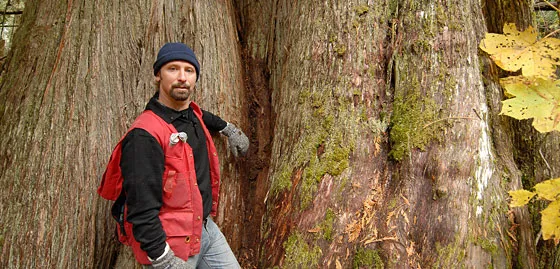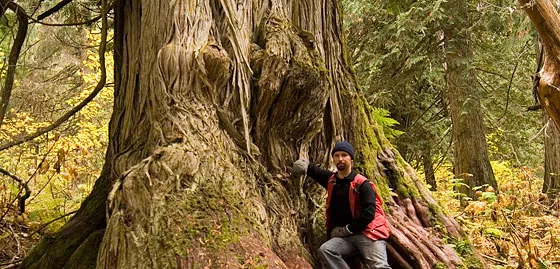Converging Interests: The Value of an Ancient Forest

Download the high-resolution image.
"I’ve never seen something quite like this, where the cedars are this big and old."
Imagine cedar trees thousands of years old and several metres around. This isn’t Haida Gwaii or Vancouver Island. It’s an ancient rainforest 1000 kilometres inland and UNBC student Dave Radies was the first to tell people about it.
It’s a place he didn’t set out to find. In fact, Radies was conducting research on lichen biodiversity and had the area 130 kilometres east of Prince George targeted as one of his randomly selected research sites. What he actually found was a relic of the past and a treasure for today. Massive western red cedar trees, some estimated to be 2000 years old, rise from the forest floor in numbers not seen anywhere this far north or this far inland. “It’s just an incredible area,” says Radies. “There are other big trees in the vicinity, but I’ve never seen something quite like this, where the cedars are this big and old. It’s like a rainforest, but it’s probably more appropriate to call it a snow forest because of the amount of snow this region gets in a typical winter.”
Radies found something else, too: flagging tape, indicating that the area was designated for logging. Cue the familiar debate about determining the value of forests. Who or what is most important? Biodiversity? Resource-based communities? Recreationalists? The forest industry? Sometimes, the answer is dependent on the context. In the foothills of the Rocky Mountains, the annual snow and rainfall accumulations are so high that the area resembles a coastal rainforest. The cedars grow big and old, but they also rot from the inside so they’re not very useful for typical lumber production. Local sawmills over the years have tried – and generally failed – to successfully use the trees, and local employment has suffered as a result. However, in nearby McBride, the TRC Cedar mill is trying and succeeding, employing 45 people to make different products such as materials for fencing and roofing. Just two logging truck loads per day keep the last mill left in the community running.


Dave Radies in the Ancient Forest. Download the high-resolution image.
But is employment the only forest value worth considering? Dave Radies doesn’t think so and neither do many other residents of the region. They’ve built a trail through the Ancient Forest and hope to attract tourists traveling along Highway 16 between Prince George and Jasper. Radies believes the biodiversity contained within the area is mind-boggling, with probably 1000 species of lichen and fungi alone. But does that mean the area should be off-limit to foresters? “Parts of it, definitely, especially the wet cedar forests,” says Radies. “The area makes up less than 1% of the Prince George Timber Supply Area, after all. It comes down to recognizing that there are different kinds of forests and we should be doing more to utilize different tree species that are more common and grow quickly, such as birch and aspen. That’s where government policy and leadership has been lacking. We really don’t know anything about how this old cedar ecosystem works or what would even be an optimum level of harvesting. These forests are rare and certainly the oldest in the BC Interior so we only have one chance to do this right.”
Since stumbling into the Ancient Forest, Radies remains passionate about the area and the role science can play in ensuring that these kinds of “snow forests” are managed properly. Multiple UNBC researchers and classes have visited the region to study the region’s biological systems, and their value for recreation, biodiversity, and economics. It’s fitting that one of the oldest and largest trees along the Ancient Forest trail is named the Radies Tree.

Dave Radies with the Radies tree in the Ancient Forest. Download the high-resolution image.

A map indicating the location of the Ancient Forest Trail. Download the high-resolution image.
Dave Radies moved to Prince George from Delta in 1998 to pursue a bachelor's degree at UNBC. He has been conducting research in the forests between Prince George and McBride for 8 years and will be starting his PhD at UNBC this winter.
Video
Broadcast-quality video footage is available for the news media. Contact the Communications Office.
Contact:
Dave Radies
Graduate Student
Natural Resources and Environmental Studies
(250) 960-5673
Contact: